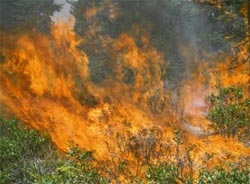Wildfire and an example of its important link to the ecosystem

Wildfires used to be a natural part of Sierran ecosystems, with minor fires sweeping through at intervals of 10 to 25 years. Credit: Photo courtesy of Dale Johnson and Soil Horizons/Soil Science Society of America<br>
Traveling the western U.S. state of Nevada in the 1860s, a young American writer named Mark Twain heard a “world of talk” about the beauty of Lake Tahoe and so set out one August day to see the lake perched high in the Sierra Nevada Mountains. Determined to make the 11-mile journey on foot, Twain and his companions became briefly discouraged after toiling up one mountain and then another to no avail. But they trudged on until “at last the Lake burst upon us,” Twain wrote in his 1872 book, Roughing It.
One hundred and fifty years later, visitors to this border region between California and Nevada still marvel at Lake Tahoe, but sadly the “jewel of the Sierra” is not the same gem it was in Twain's time. Boating on the lake during his trip, Twain said he could see rocks at least 80 feet below the surface—a degree of clarity that scientists attribute to “ultra-oligotrophic” conditions, meaning exceptionally nutrient-poor and pure. Since the 1960s, however, Lake Tahoe's renowned water quality has been in slow decline, and exactly why “is the $64,000 question,” says soil scientist Dale Johnson of the University of Nevada in Reno.
Damaging blazes sweep the Tahoe region regularly, and by the time Johnson teamed up with his University of Nevada colleague, Wally Miller—an expert on Tahoe's water quality—scientists already knew how catastrophic fires could affect downstream streams and lakes. Wildfire can leave slopes bare of vegetation and unprotected from erosion. Burning also releases nitrogen, phosphorus, sulfate, and other biochemicals locked in plants, wood, and soils, allowing the nutrients to run off downslope or seep into groundwater. But when Miller and Johnson began their studies, they discovered something that few, if anyone, had suspected: Not only could a major disturbance like fire affect Lake Tahoe, but so too could a lack of disturbance—the absence of fire. “The results were very surprising and therefore very hard to publish,” Johnson says. “No one believed it.”
But the findings also lead to a dilemma. On one hand, wildfire is beneficial in that it burns away decades of accumulated organic material, which Johnson and Miller have shown can potentially be a slow but significant source of nutrients to Lake Tahoe. On the other hand, severe wildfire can also deplete forests of nitrogen and send pulses of nutrients downstream—not to mention the damage it does to timber and private property.
“So what do you do?” Miller asks. The answer lately embraced by forest managers is to mimic the natural, Sierran fire regime that existed before aggressive fire suppression began. Managers will purposely light small, controlled fires to burn away accumulated woody debris. Or they'll remove wood with harvesting equipment or chip it on site.
But managers don't want to remove too many nutrients from the system, since they're needed to support future generations of trees. So Miller and Johnson have been studying the practices' impacts on nutrients and on water quality, just as they earlier investigated catastrophic wildfire and fire suppression.
Media Contact
More Information:
http://www.agronomy.orgAll latest news from the category: Ecology, The Environment and Conservation
This complex theme deals primarily with interactions between organisms and the environmental factors that impact them, but to a greater extent between individual inanimate environmental factors.
innovations-report offers informative reports and articles on topics such as climate protection, landscape conservation, ecological systems, wildlife and nature parks and ecosystem efficiency and balance.
Newest articles

Properties of new materials for microchips
… can now be measured well. Reseachers of Delft University of Technology demonstrated measuring performance properties of ultrathin silicon membranes. Making ever smaller and more powerful chips requires new ultrathin…

Floating solar’s potential
… to support sustainable development by addressing climate, water, and energy goals holistically. A new study published this week in Nature Energy raises the potential for floating solar photovoltaics (FPV)…

Skyrmions move at record speeds
… a step towards the computing of the future. An international research team led by scientists from the CNRS1 has discovered that the magnetic nanobubbles2 known as skyrmions can be…





















